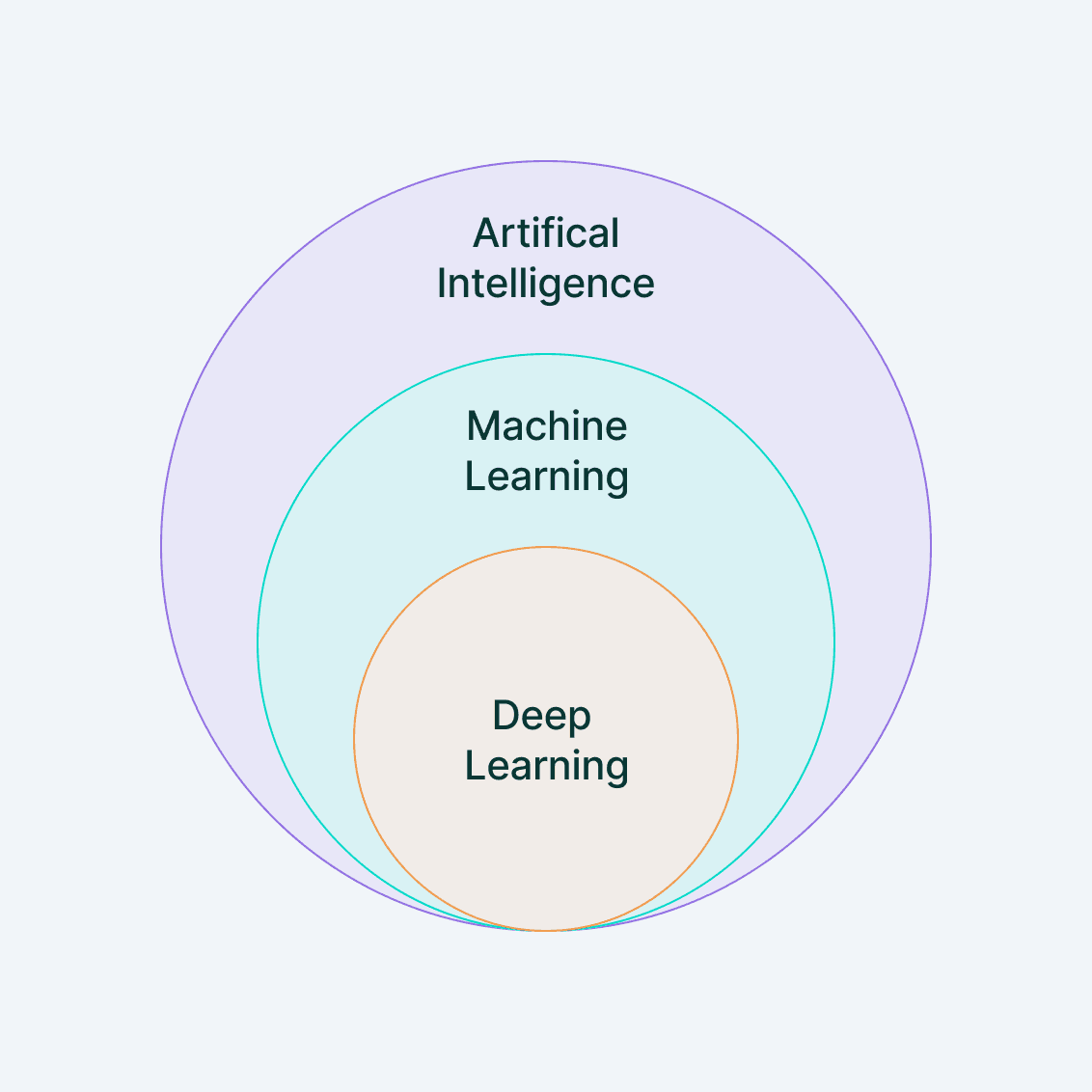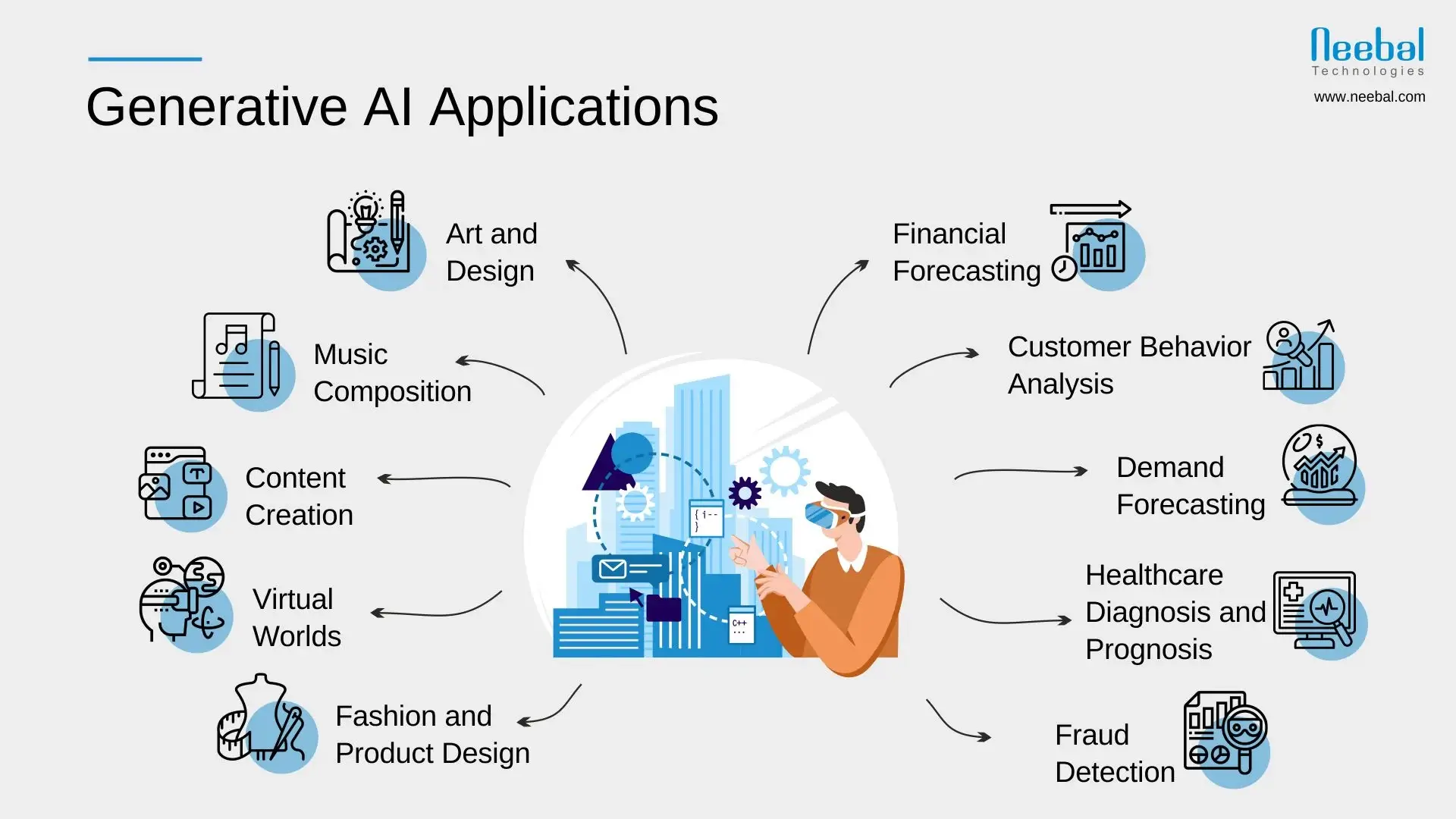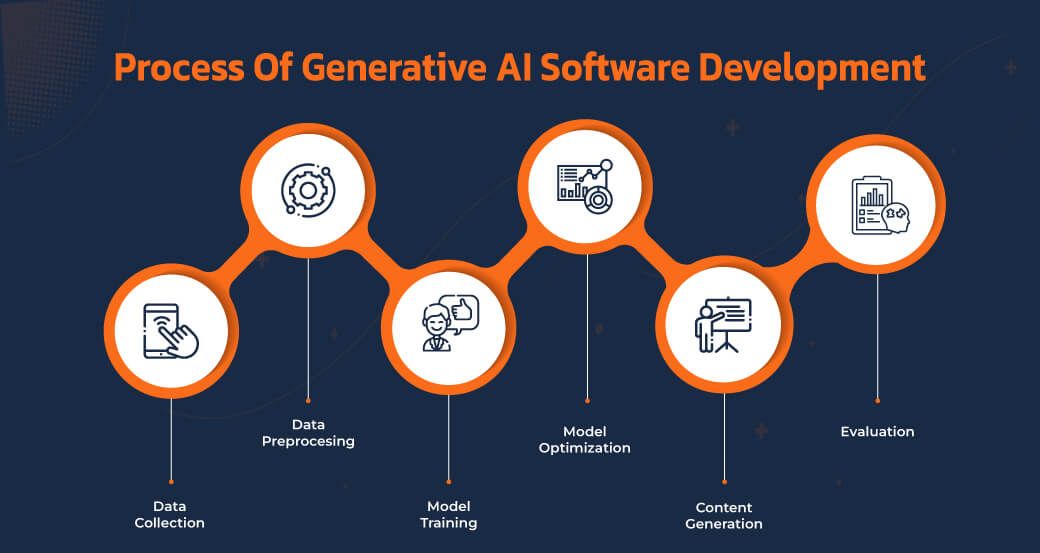Generative AI is revolutionizing how machines can create original content and art. As per Statista, investments in generative AI startups reached $1.38 billion in 2021, a massive 10x increase from 2020 (1). Key applications like DALL-E 2 by OpenAI and ChatGPT by Anthropic have demonstrated the capabilities of this technology.
Generative AI models are trained on vast datasets to generate new outputs like images, text, code, audio and more. They can bring ideas to life with human-level imagination and creativity. The global generative AI market is projected to grow from $4.3 billion in 2022 to $245.9 billion by 2032 according to Globenewswire.
As generative AI continues making breakthroughs, understanding its fundamentals is important. This guide covers the basics of generative AI techniques like generative adversarial networks, variational autoencoders, diffusion models and transformer networks. It explains key concepts, architectures, training approaches, applications, limitations and future directions. For anyone looking to get started with generative AI, this primer serves as the perfect introduction.
Understanding Generative AI

Artificial Intelligence (AI) has revolutionized various industries by enabling machines to perform tasks that typically require human intelligence. Within the field of AI, different branches are focusing on specific aspects. One such branch is Generative AI, which holds immense potential for transforming how we create and interact with digital content.
Explanation of AI and its Different Branches
AI is a field of computer science that aims to develop intelligent machines capable of simulating human cognitive processes. It involves creating algorithms and models that enable machines to perceive, reason, learn, and make decisions.
There are several branches within AI, each focusing on specific areas. These branches include Machine Learning (ML), Natural Language Processing (NLP), Computer Vision, Expert Systems, Robotics, and Generative AI.

Generative AI and its Purpose
Generative AI, also known as creative AI, is a branch of AI that focuses on creating models and algorithms capable of generating new content. Unlike other branches of AI that focus on recognizing patterns and making predictions, Generative AI is concerned with creating novel and unique content.
The purpose of Generative AI is to push the boundaries of human creativity and enable machines to generate content autonomously that is indistinguishable from human-created content. This technology can potentially revolutionize various industries, including art, music, design, and entertainment.
How Generative AI Differs from Other Forms of AI?
While other forms of AI focus on tasks such as image recognition, speech synthesis, and decision-making, Generative AI goes beyond these capabilities. Instead of relying on pre-existing data to make predictions or classifications, Generative AI models create new content based on patterns and knowledge learned from training data.
Generative AI models can generate realistic images, compose music, write stories, and even develop new designs. They are capable of exploring vast possibilities and producing output that is both surprising and creative.
Key Concepts in Generative AI
To understand Generative AI better, it is important to grasp some key concepts and techniques that underpin this field.
Generative models: Definition and Types (e.g., GANs, VAEs)
Generative models are at the core of Generative AI. These models are trained on large datasets and learn the underlying patterns and structures within the data. They can then generate new content that is similar to the input data.
There are different types of generative models, such as Generative Adversarial Networks (GANs) and Variational Autoencoders (VAEs). GANs consist of two neural networks - a generator and a discriminator - that compete against each other to improve the quality of generated content. VAEs, on the other hand, are probabilistic models that learn the distribution of the input data and generate new samples from that distribution.
Training Algorithms for Generative AI models
Training generative models involves providing them with large amounts of relevant data and optimizing their parameters to learn the underlying patterns. This process typically involves backpropagation, stochastic gradient descent, and other optimization algorithms.
During training, the generative models learn the statistical distribution of the input data and use this knowledge to create new content that resembles the training data. The quality of the generated content improves with more training iterations and better optimization techniques.
Suggested Reading:
Key applications and use cases

Generative AI has a wide range of applications in various industries. Some key applications include:
Art and Design: Generative AI can automate the creation of unique artworks, designs, and graphics. It can assist artists in generating new ideas and exploring different styles.
Music Composition: Generative AI models can compose music in various genres or create new melodies based on existing compositions. This application can help musicians and composers in the creative process.
Content Generation: Generative AI can generate text, stories, and articles that mimic the style and tone of specific authors or genres. It can be used to produce automated content for news articles, product descriptions, and social media posts.
Virtual Worlds: Generative AI can create realistic and immersive virtual worlds, generating landscapes, characters, and objects that mimic real-world environments.
Now, Generative AI also finds its potential in the realm of customer service in the form of AI-powered chatbots.
And, if you want to begin with chatbots but have no clue about how to use Generative AI to train your chatbot, then check out the NO-CODE chatbot platform, named BotPenguin.
Tools and Technologies for Generative AI
Generative AI development requires the use of specific tools, frameworks, and technologies. These tools enable developers to create and train generative models effectively and efficiently. In this section, we will explore some popular tools and considerations for Generative AI development.
Popular Frameworks and Libraries for Generative AI Development
Frameworks and libraries provide the necessary infrastructure and pre-built components to streamline the development process of generative models. Some popular frameworks for Generative AI development include:
TensorFlow: TensorFlow is an open-source machine learning framework developed by Google. It provides a comprehensive ecosystem for building and training generative models, including tools like TensorFlow.js for JavaScript-based development.
PyTorch: PyTorch is another popular open-source machine learning library. It offers a dynamic computation graph and a user-friendly interface for implementing generative models. PyTorch also offers high-level API libraries like TorchVision and TorchAudio for computer vision and audio-related tasks.
Keras: Keras is a high-level neural networks API written in Python. It provides a simple and intuitive interface for building generative models. Keras also has tight integration with TensorFlow, making it a powerful tool for Generative AI development.
Hardware requirements and considerations
Generative AI development can be computationally intensive, often requiring access to powerful hardware resources. Here are some considerations regarding hardware:
CPU vs. GPU: While Generative AI models can be trained on CPUs, utilizing a GPU (Graphics Processing Unit) can significantly accelerate the training process. GPUs are specifically designed to handle parallel computing tasks and are highly suitable for deep learning applications.
Cloud-based solutions: Cloud service providers like Amazon Web Services (AWS), Google Cloud Platform (GCP), and Microsoft Azure offer scalable and cost-effective solutions for running Generative AI models in the cloud. These services provide access to high-performance GPUs and allow developers to scale their infrastructure based on their needs.
Data Processing and Preparation for Generative Models
Data plays a vital role in training generative models. The quality and structure of the training data greatly influence the performance and creativity of the generated content. Here are some considerations for data processing and preparation:
Data cleaning: Before feeding data to generative models, it is crucial to preprocess and clean the data. This process involves removing noise, handling missing values, and ensuring data consistency.
Data augmentation: Data augmentation techniques can be applied to increase the diversity and size of the training dataset. Techniques like cropping, rotation, and mirroring can help introduce variations and improve the model's ability to generate diverse outputs.
Normalization: Normalizing data to a common scale can improve the training process and help the generative model learn more effectively. Common normalization techniques include rescaling features or using techniques like StandardScaler or MinMaxScaler.
Suggested Reading:
Getting Started with Generative AI Development
To begin developing generative models, it is important to set up a suitable development environment and gain a fundamental understanding of coding techniques specific to Generative AI.

Steps to Set Up a Development Environment
Setting up a development environment for Generative AI involves the following steps:
Install the Required Frameworks and Libraries: Depending on your chosen framework (such as TensorFlow or PyTorch), follow the installation instructions provided by the respective documentation.
Choose the Development Platform: You can develop Generative AI models using a programming language such as Python or JavaScript. Select the platform based on your familiarity and the specific requirements of your project.
Set up Hardware Resources: Ensure that you have access to sufficient computing resources, such as a powerful CPU or GPU, based on the hardware considerations discussed earlier.
Basics of Coding Generative AI Models
Coding Generative AI models involves understanding the fundamental concepts and techniques specific to Generative AI. Some key coding techniques include:
Defining the model architecture: This involves setting up the structure and layers of the generative model, including the input and output dimensions.
Implementing training algorithms: Develop code to train the generative model using techniques like backpropagation and optimization algorithms like stochastic gradient descent.
Generating new output: Write code to generate new content using the trained generative model. This typically involves sampling from the learned distribution or decoding latent variables.
Essential Resources and Learning Materials
To learn and improve in Generative AI development, it is essential to explore available resources and learning materials. Here are some recommended resources:
Online courses and tutorials: Platforms like Coursera, Udemy, and edX offer courses specifically focused on Generative AI, providing a structured learning experience with hands-on exercises.
Research papers and publications: Stay up to date with the latest research in Generative AI by reading research papers, blog articles, and technical publications.
Websites like ArXiv and OpenAI provide access to various research papers.
Community forums and meetups: Engage with the Generative AI community by participating in online forums (such as Reddit and Stack Overflow) or attending meetups and conferences. Sharing knowledge and discussing ideas with fellow developers can greatly enhance your understanding and skills.
By following these steps and utilizing the available resources, you can kickstart your journey into Generative AI development and start creating your own innovative content.
Now, Here is an example of how you can use Generative AI for your business the easy way, #the NO-CODE way!
Challenges and Ethical Considerations in Generative AI
Generative AI has made significant advancements in recent years, enabling machines to generate realistic and creative outputs. However, along with its potential benefits, Generative AI brings several challenges and ethical considerations. In this article, we will explore some of these challenges and shed light on the responsible use of Generative AI.
Data Quality and Bias
One of the primary challenges in Generative AI is the quality and bias in the training data. Generative models learn from large datasets, and if the training data is biased or contains errors, it can result in biased or inaccurate generated outputs.
Addressing data quality issues requires careful data preprocessing, cleaning, and ensuring diverse representation to avoid perpetuating biases.
Uncertainty and evaluation
Measuring the performance and evaluating the quality of generated outputs is another challenge in Generative AI. Unlike discriminative models, it is not straightforward to quantify uncertainty and assess the fidelity of generated content. Developing effective evaluation metrics and techniques is an ongoing area of research.
Overfitting and generalization
Generative models can sometimes overfit the training data, generating outputs that closely resemble the training examples but lack creativity or diversity. Balancing model complexity, regularization techniques, and data augmentation can help improve generalization and foster creativity in generated content.
Conclusion
In summary, this guide has provided a comprehensive introduction to the fundamentals of generative AI. Key techniques like GANs, VAEs, diffusion models, and transformers were explained in detail.
Crucially, generative AI opens up new possibilities for leveraging AI creativity, imagination, and problem-solving abilities. As per Grand View Research, the generative design software market is projected to reach $547.5 million by 2030, growing at a CAGR of 15.6%. Applications across industries like generating synthetic media, data augmentation, drug discovery, and more will drive growth.
However, concerns around copyright, misuse, and bias need to be addressed through research and regulation. Going forward, advances in computing, algorithms, and data will enable generative AI models to become increasingly sophisticated and multi-modal. Understanding the core concepts will help developers and researchers build the next generation of imaginative, human-centric generative AI.
Suggested Reading:
Frequently Asked Questions (FAQs)
What programming languages are commonly used in generative AI development?
Popular programming languages for generative AI include Python, TensorFlow, and PyTorch. These languages offer robust frameworks and libraries that streamline the implementation of neural networks, facilitating the development of generative AI models.
How does ethical consideration play a role in generative AI development?
Ethical considerations are crucial in generative AI development, especially concerning issues like bias, privacy, and misuse of generated content. Developers need to implement safeguards and responsible practices to ensure the ethical deployment of generative AI technologies.
What are the challenges associated with generative AI development?
Challenges include mode collapse (repetitive generation), training instability, and ethical concerns. Overcoming these challenges requires a nuanced understanding of the algorithms, continuous improvement in model architectures, and adherence to ethical guidelines.
Are there any notable examples of successful generative AI applications in the industry?
Yes, notable examples include StyleGAN for realistic image synthesis, OpenAI's GPT-3 for advanced natural language processing, and DALL-E for generating diverse and creative images based on textual descriptions.
How can beginners start learning generative AI development?
Beginners can start by acquiring a solid understanding of machine learning fundamentals, exploring online courses and tutorials on platforms like Coursera and Udacity, and experimenting with simple generative AI projects using frameworks like TensorFlow and PyTorch.

